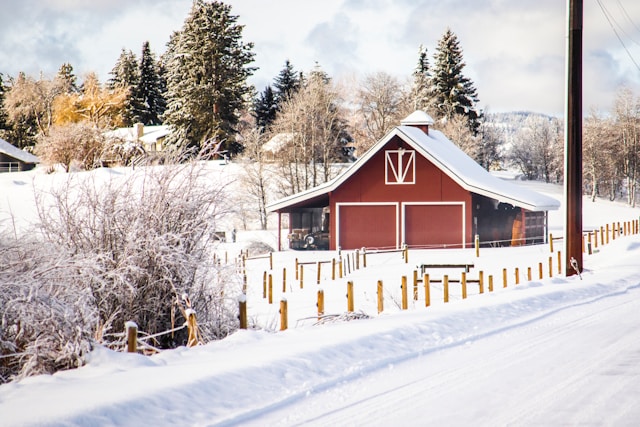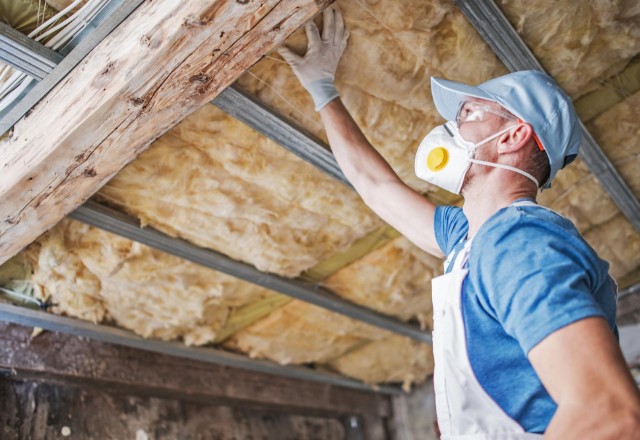Insulating the barn ceiling is a game-changer. Say goodbye to extreme temperatures – whether scorching heat or icy chills – by upgrading your insulation game. By insulating your pole barn’s ceiling, you create a stark contrast in comfort levels year-round. Not only does it regulate temperature, but it also helps cut down on those pesky energy bills. Ready to transform your space into a cozy haven? Let’s dive into the world of insulating pole barn ceilings and discover how this simple upgrade can make all the difference.

Understanding Ceiling Insulation
Heat Transfer
Conduction involves heat moving through direct contact between objects. For instance, metal roofing in pole barns conducts heat well due to its high thermal conductivity. By insulating the ceiling, you can reduce heat conduction and enhance energy efficiency significantly.
Convection refers to heat transfer through fluid or gas movement. Proper insulation minimizes convective heat loss in a pole barn’s ceiling by preventing air currents from forming. Installing insulation with low air permeability is crucial for stopping convective heat loss effectively.
Radiation signifies the transfer of heat via electromagnetic waves. Radiant barriers are utilized to deflect radiant heat away from the pole barn’s ceiling. Opting for insulation with high emissivity ensures effective absorption and emission of radiant heat, enhancing overall insulation performance.
R-Value Importance
The R-value gauges the thermal resistance of insulating materials; higher R-values indicate better performance and more significant energy savings potential. Familiarizing yourself with the required R-value for your pole barn ceiling is essential for efficient insulation that promotes optimal energy conservation.
Types of Insulation Materials for Barn Ceilings
Spray Foam
Spray foam insulation is a popular choice for insulating pole barn ceilings. It expands upon application, effectively sealing all gaps and voids in the ceiling. This airtight seal helps prevent drafts and significantly reduces energy loss. Spray foam insulation boasts a high R-value per inch, providing exceptional thermal performance.
Pros:
Excellent at filling gaps and voids
Airtight seal prevents drafts
High R-value for superior thermal performance

Fiberglass
Another common option for pole barn ceiling insulation is fiberglass. Made from fine glass fibers, this material comes in various thicknesses to suit different ceiling configurations. Fiberglass insulation is versatile, non-combustible, and enhances fire safety measures within the barn.
Pros:
Versatile material suitable for different configurations
Non-combustible nature improves fire safety
Reflective Insulation
Reflective materials are often used alongside other insulating types to deflect radiant heat away from the pole barn ceiling surface. These materials help enhance thermal performance by reducing cooling costs in hot climates while working hand-in-hand with traditional insulations like fiberglass or spray foam.
Need A Reliable Contractor For Pole Barn Ceiling Insulatiom Project?
Call us 509-201-4190 or send the form
Choosing Insulation
Factors to Consider
Insulating a pole barn ceiling involves considering various factors. The climate of the area, available budget, and adherence to building codes are crucial. Understanding the size and layout of the pole barn is essential for effective insulation planning. Seeking advice from an insulation professional can help determine the most suitable solution tailored to specific needs.
When opting for pole building insulation, it’s vital to follow best practices for optimal results. Proper installation techniques play a significant role in ensuring efficiency. Adhering to manufacturer guidelines and industry standards guarantees that the insulation performs effectively over time. Regular maintenance and inspections are recommended as they help detect any issues promptly, ensuring long-term functionality.
Best Practices
Consider climate, budget, and building codes
Understand pole barn size and layout for proper planning
Follow manufacturer guidelines diligently
Prioritize proper installation techniques
Conduct regular maintenance checks

Installation Process
Spray Foam Steps
The installation of spray foam insulation for a pole barn ceiling involves several key steps. Surface preparation is crucial to ensure the effectiveness of the insulation. Mixing the foam components accurately is essential for optimal performance. Professional installers utilize specialized equipment to apply the spray foam evenly across the ceiling, ensuring thorough coverage and proper curing.
During the process, safety precautions are paramount. Installers must wear protective gear such as masks and gloves to prevent exposure to chemicals in the foam. Following these guidelines guarantees a safe working environment and successful application of the insulation. The meticulous approach taken by professionals results in a well-insulated pole barn that offers superior thermal protection.
Ensuring Thermal Break
A critical aspect of insulating a pole barn ceiling is creating a thermal break to prevent heat transfer between materials or surfaces. By installing insulation with high thermal resistance, an effective barrier against heat flow is established within the structure’s ceiling. Properly sealing any gaps or joints further enhances this thermal barrier, ensuring minimal heat loss through conduction or convection pathways.

Benefits of Insulation
Energy Efficiency
Insulating a pole barn ceiling is crucial for improving energy efficiency. By reducing heat loss or gain, insulation helps in lowering heating and cooling costs all year round. This energy-saving measure not only benefits your wallet but also contributes to environmental sustainability by minimizing the need for excessive energy consumption.
Insulation plays a significant role in enhancing the comfort level within a pole barn. It helps regulate temperature, ensuring that the interior remains cozy regardless of external weather conditions. Temperature fluctuations are reduced, creating a more stable and pleasant environment for occupants. Insulation aids in dampening noise transmission within the structure, further elevating overall comfort levels.
Reduces heat loss or gain
Lowers heating and cooling costs
Contributes to environmental sustainability
Comfort Improvement
By insulating your pole barn ceiling, you can enjoy improved comfort inside the structure. The regulated temperature ensures that occupants experience consistent warmth or coolness as needed throughout different seasons. Noise reduction is an added benefit of insulation, providing a quieter and more peaceful atmosphere inside the pole barn.
Regulates temperature effectively
Minimizes temperature fluctuations
Reduces noise transmission

Heating Systems Overview
Types of Systems
Insulating pole barn ceilings can be done using various systems like batt insulation, blown-in insulation, and spray foam insulation. Each system offers unique benefits based on the pole barn’s specific needs. Consulting with an expert can help determine the most suitable option for optimal results.
Batt insulation consists of pre-cut panels that fit between ceiling joists, providing a cost-effective solution. Blown-in insulation involves blowing loose-fill materials into the ceiling cavities, ideal for irregularly shaped areas. Spray foam insulation creates a seamless barrier with high R-values for superior thermal resistance.
Energy-Efficient Options
For insulating pole barn ceilings efficiently, consider high-performance materials with excellent thermal resistance capabilities to reduce energy consumption and costs. Combining different types of insulations or utilizing hybrid systems can further enhance energy efficiency by minimizing heat transfer through the ceiling structure.
Investing in energy-efficient options not only helps in reducing utility bills but may also make you eligible for rebates or incentives from utility companies or government programs as a reward for promoting sustainable practices.
Summary
Now that you’ve grasped the ins and outs of insulating your pole barn’s ceiling, you’re armed with the knowledge to make an informed decision. From understanding the types of insulation materials available to learning about the installation process and the benefits it brings, you’re well-equipped to tackle this project head-on. By combining the right insulation with a suitable heating system, you can create a cozy and energy-efficient space in your barn.
Take the next step and put your newfound knowledge into action. Start by assessing your barn’s needs, selecting the appropriate insulation material, and planning out the installation process. With a well-insulated ceiling and an efficient heating system in place, you’ll not only enhance the comfort of your barn but also save on energy costs in the long run.




 509-201-4190
509-201-4190
